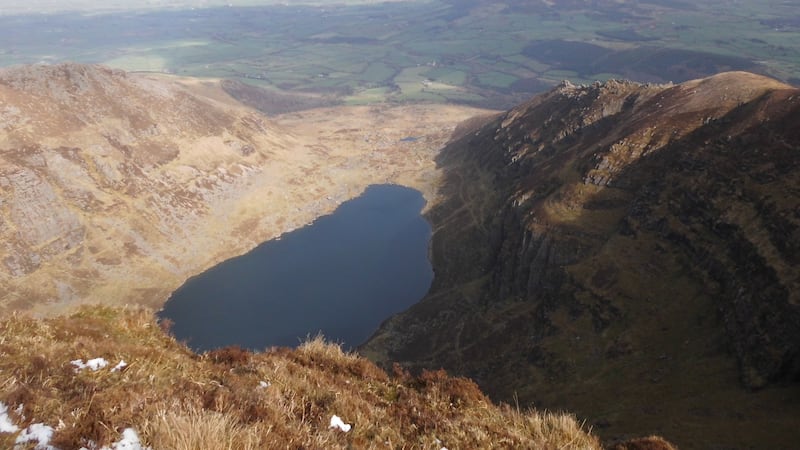Raising sheep is in Willie Drohan’s blood. And so are the Comeragh mountains. Fifteen years ago he found a way to combine the two. Now his Comeragh Mountain Lamb is served at great restaurants and food shops around Ireland.
Touring his mountainside farm one afternoon, he stops to point out the flock of Scottish Blackface sheep scattered up the hillside. On this sparkling day, turn around and you can see Dungarvan harbour and Helvick Head 20km away.
Drohan’s lambs will spend most of their lives here scavenging among the brush for wild grasses and herbs. The most ambitious will crest the hill and find the blanket bog, even richer in wild plants. This diet, replete with fescue, moor grass, heather and sorrel, contributes to lamb with a profound flavour, nearly sweet with an unmistakable hint of liquorice or fennel.
Drohan, 50, is the sixth generation in his family to farm on this little bit of paradise and he’s been working with sheep here since he was nine-years-old. The farm was started by his ancestors William Cooney and Catherine Curran in 1820, tenant farmers of the Palliser family from nearby Comeragh House.
READ MORE

The land was passed down through the generations. In the 1850s, two Cooney daughters collected stones from the fields and built a house, the bones of which are still evident in Cooney’s Yard, the popular cafe started a few years ago by Drohan’s wife Bridget, next to the new family home.
Willie inherited this farm and a neighbouring one from his uncles when he was just 19 years old. But farming was changing and it was getting more and more difficult to earn a living raising lamb that would just disappear into the generic commodity stream.
So in 2008, he and his brother-in-law, Aidan Dunwoody, decided the best way out of that trap was to market their lamb themselves, forming Comeragh Mountain Lamb, betting that others would recognise the quality of the meat they raised and would be willing to pay a premium for it.
They earned fans quickly. First, they approached Michael Quinn, then chef at Waterford Castle hotel, now a lecturer in culinary arts at southeast Technical University in Waterford. “What really got me was when I made stock from the bones, there was a liquorice taste to it that I’d never got before,” Quinn remembers. “It intrigued me, I couldn’t believe the difference between that and lowland lamb.”
Quinn served it at a banquet for the Euro-Toques organisation of chefs and food producers and soon the orders started coming in. “The lambs eat what they want and they drink the spring water,” Quinn says. “All that has an effect on the meat. It isn’t strong, but it is like a sweet, perfumed flavour. The wild herbs, the heather...You can taste the effect it has on the animal.”
When he was chef at Waterford Castle, Quinn served a lamb sampler with a confit belly, braised shoulder and medium-rare loin. Cooking at home, he’s more likely to roast a boned and tied shoulder at 155 degrees to an internal temperature of 60 to 65 degrees, so that it’s firm but still pink, let it rest for at least a half-hour and then carve it thin.
The other day, I seared some stew meat (mostly trimmings from the shank, it looked like), then braised it in red wine. For the last half-hour or so, I added peeled shallots and green olives. The flavour was deep with a hint of sweetness. In a lifetime of lamb stews, this was a keeper.
[ Eating out more expensive in Dublin than London, Paris or Rome, survey saysOpens in new window ]
Comeragh Mountain Lamb is raised in two places. Part of the flock is on a 60-acre commonage that is shared with other farmers, divided in the old system of collops, or shares in grazing rights. This system and the shares, have been handed down since at least the 19th century. The rest of the flock is kept nearby on a 700-acre farm in nearby Rathgormack that includes both mountain and pasture land. All told, Drohan figures they sell 800 to 900 lambs a year.
The flock moves between the mountainside and pasture depending on the season, with the lambs spending roughly half of their lives foraging on the hillsides. They come down to pasture in July to develop just enough of a fat cap for flavour. The lambs are taken to O’Flynn Meats in Waterford to be slaughtered from August through early April.
Spring lamb from the mountains is almost a year old. Drohan says much younger than that and the meat is tender, but lacks flavour. As the harvest season ends, next year’s lambs are born and the cycle begins again.
The Drohan family are all involved in the process. The two oldest, daughters 16-year-old Ellen and 14-year-old Alice, already are raising sheep of their own. Grainne, 13 and Niamh, 10, are waiting their turn. The youngest, seven-year-old Bill, is working on a report on sheep farming for his school.
And so it seems that the seventh generation seems likely to continue the family’s sheepherding tradition in the Comeraghs. Without it, something vital to Irish food culture would be lost.
“There’s something special about mountain sheep,” Drohan says. “They may break your heart at times, but there’s something special about them and there’s something special about the mountains. I do believe it’s a way of life that needs to be looked after.”
Comeragh Mountain Lamb can be purchased from the website, comeraghmountainlamb.ie, at Ardkeen Store in Waterford, Fresh Food Court and Garvey’s SuperValu in Dungarvan.
















